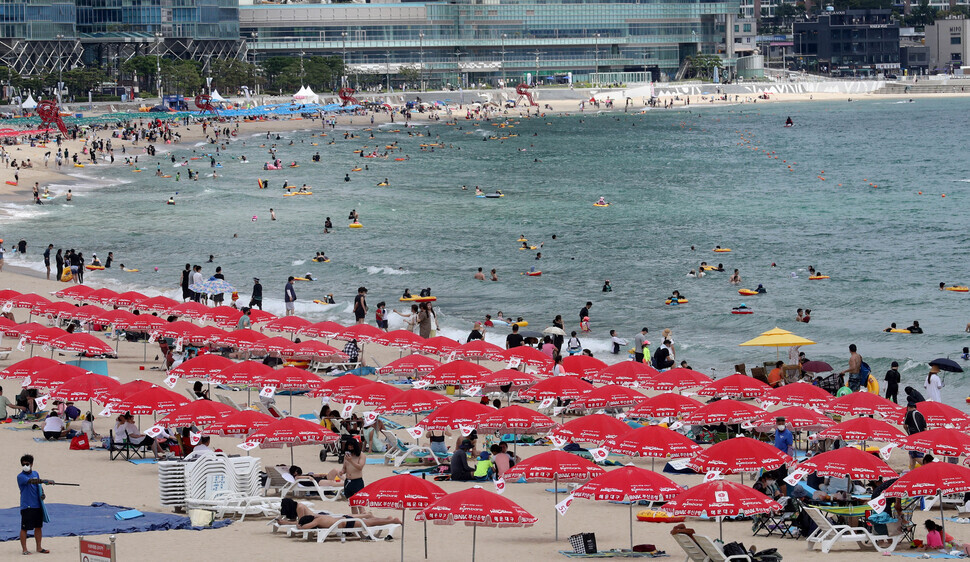hankyoreh
Links to other country sites 다른 나라 사이트 링크
COVID-19 is spreading faster outside of greater Seoul

The South Korean government’s decision to allow private gatherings of only four people at a time outside of the greater Seoul area for the two-week period beginning Monday was based on concerns that rapidly rising confirmed cases in greater Seoul could trigger a “balloon effect” in the rest of South Korea, as well as worries about increased travel during the holiday season.
Since the start of the fourth wave, the spread of COVID-19 has been a nationwide phenomenon, with regions outside of greater Seoul accounting for over 30% of all new confirmed cases.
On Sunday, the Central Disease Control Headquarters (CDCH) announced that 1,454 new confirmed cases had been recorded by the end of the day on Saturday.
It was the 12th straight day with a four-digit new caseload, dating back to the 1,212 new confirmed cases on July 7. The Saturday total included 1,402 domestic cases, 969 of which (69.4%) were diagnosed in greater Seoul and 443 (31.6%) were diagnosed in other regions.
Commenting at a Sunday briefing on the COVID-19 situation over the preceding week, Son Young-rae, director of the social strategy group for the Central Disaster Management Headquarters, said, “As the situation persists in greater Seoul, it’s translating into a clear trend of increase in the rest of Korea.”
Indeed, while the greater Seoul region’s daily average of new confirmed cases between Monday and Sunday amounted to 990, or 140.6 more than the week before, the average of 376 for regions outside of greater Seoul over the same period was up 155 from the week before. In other words, the increase in patients outside the Seoul area was greater than the increase within it.
The South Gyeongsang and Chungcheong regions have seen particularly high caseloads.
Over the week from Monday to Sunday, South Gyeongsang recorded the highest average daily confirmed cases outside the greater Seoul area at 142.4. This indicates a rapid rise from the region’s daily average of 79.3 a week earlier.
In the Chungcheong region, the daily average over the past week was 100 patients, up visibly from the 70.3 daily average a week earlier.
Other rises were observed over the same period for the regions of North Gyeongsang (20.7 to 52.3), Honam (21.4 to 40.4), and Gangwon (14 to 28.3). Jeju experienced a drop in its daily average from 15.4 to 12.9 cases — but with daily new caseloads typically averaging less than five patients before the fourth wave erupted, the sense of alarm there has grown.
The number of allowable people in private gatherings has been sharply reduced in most regions as the CDCH moved Sunday to limit the cap to four for all areas outside of greater Seoul.
Another reason the rise in patients outside of greater Seoul is fanning fears is the relative shortage of medical resources, including hospital beds and staff, compared with the Seoul area.
With many of the recent infections occurring in people in their 20s to 50s who have yet to be vaccinated, the residential treatment centers used for patients with mild or no symptoms have been filling up especially quickly.
As of the end of the day Saturday, the average operation rate for South Korea’s 53 residential treatment centers was 66.4%. In the Chungcheong region, that rate was 92.3% — meaning only another 13 patients could be accommodated.
The regions of North Gyeongsang (82.5%) and South Gyeongsang (76.7%) also had residential treatment center operation rates above the national average. If those regions continue to experience double-digit numbers in new confirmed cases, the treatment centers currently available are poised to reach saturation shortly.
By Seo Hye-mi, staff reporter
Please direct comments or questions to [english@hani.co.kr]

Editorial・opinion
![[Editorial] Penalties for airing allegations against Korea’s first lady endanger free press [Editorial] Penalties for airing allegations against Korea’s first lady endanger free press](https://flexible.img.hani.co.kr/flexible/normal/500/300/imgdb/original/2024/0502/1817146398095106.jpg) [Editorial] Penalties for airing allegations against Korea’s first lady endanger free press
[Editorial] Penalties for airing allegations against Korea’s first lady endanger free press![[Editorial] Yoon must halt procurement of SM-3 interceptor missiles [Editorial] Yoon must halt procurement of SM-3 interceptor missiles](https://flexible.img.hani.co.kr/flexible/normal/500/300/imgdb/child/2024/0501/17145495551605_1717145495195344.jpg) [Editorial] Yoon must halt procurement of SM-3 interceptor missiles
[Editorial] Yoon must halt procurement of SM-3 interceptor missiles- [Guest essay] Maybe Korea’s rapid population decline is an opportunity, not a crisis
- [Column] Can Yoon steer diplomacy with Russia, China back on track?
- [Column] Season 2 of special prosecutor probe may be coming to Korea soon
- [Column] Park Geun-hye déjà vu in Yoon Suk-yeol
- [Editorial] New weight of N. Korea’s nuclear threats makes dialogue all the more urgent
- [Guest essay] The real reason Korea’s new right wants to dub Rhee a founding father
- [Column] ‘Choson’: Is it time we start referring to N. Korea in its own terms?
- [Editorial] Japan’s rewriting of history with Korea has gone too far
Most viewed articles
- 160% of young Koreans see no need to have kids after marriage
- 2Months and months of overdue wages are pushing migrant workers in Korea into debt
- 3Presidential office warns of veto in response to opposition passing special counsel probe act
- 4Hybe-Ador dispute shines light on pervasive issues behind K-pop’s tidy facade
- 5[Editorial] Penalties for airing allegations against Korea’s first lady endanger free press
- 6Historic court ruling recognizes Korean state culpability for massacre in Vietnam
- 7Japan says it’s not pressuring Naver to sell Line, but Korean insiders say otherwise
- 8Story of massacre victim’s court victory could open minds of Vietnamese to Korea, says documentarian
- 9Historic verdict on Korean culpability for Vietnam War massacres now available in English, Vietnames
- 10[Guest essay] How Korea must answer for its crimes in Vietnam